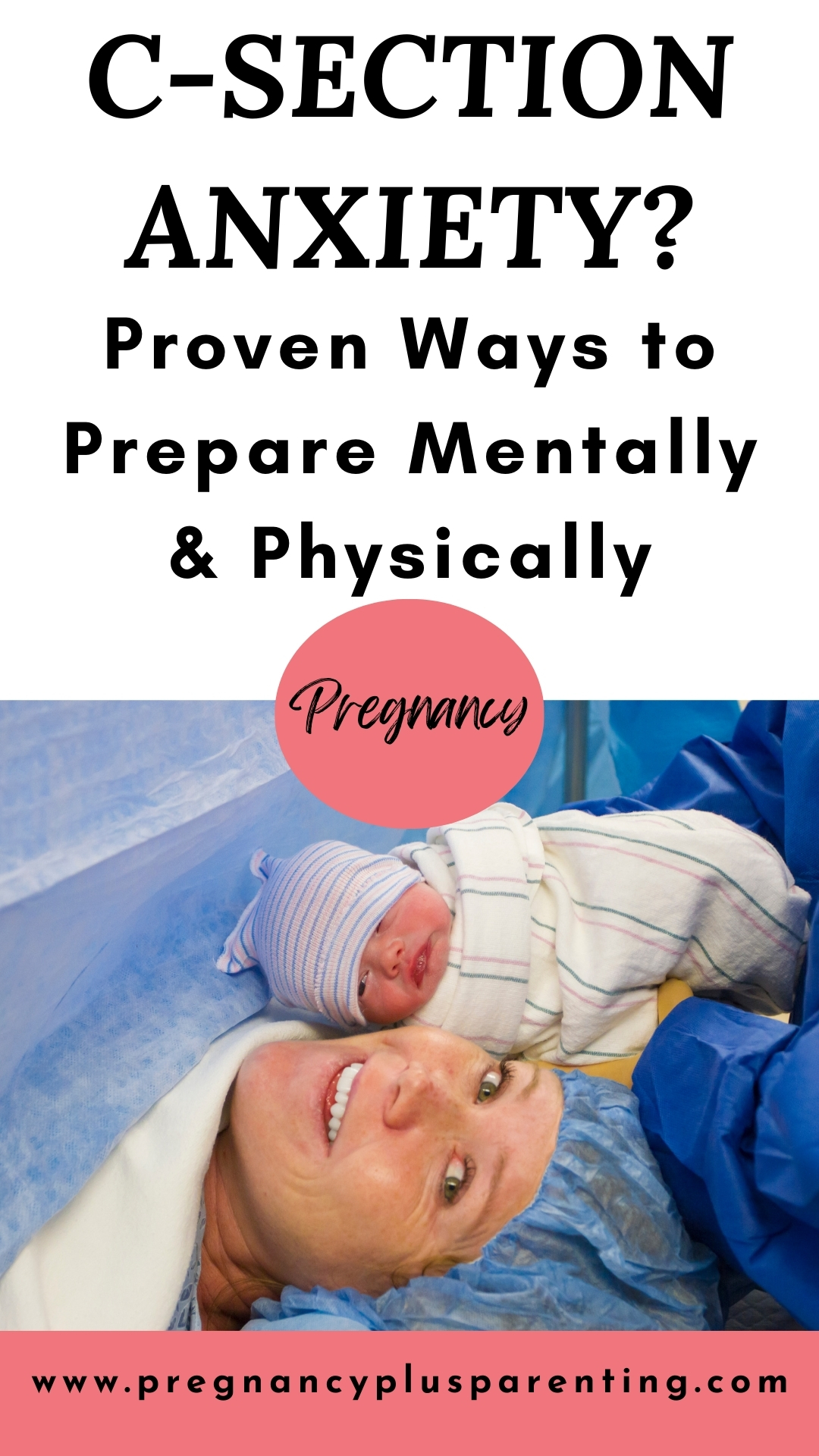C-Section Anxiety? Proven Ways to Prepare Mentally & Physically
It’s normal to feel anxious about the idea of surgery.
Fear of a cesarean section is not only a problem with a planned cesarean section; expectant mothers who are expecting their first child also often struggle with these fears.
The mere thought of a cesarean section arouses feelings of concern in many pregnant women.
The period after birth is a time of many changes for every woman.
You are now responsible for another living being and your everyday life is turned upside down.
Not only is taking on responsibility a challenge, the postpartum period , when the body heals and the psyche recovers from this rollercoaster of emotions, pushes some women to their limits.
Even if you have prepared so much for the birth, have attended a birth preparation course and perhaps one or two online courses, it is completely normal to be afraid of it.
Whether you’re having a normal birth or a planned cesarean section, it’s okay to worry.
It’s actually a good sign because it means you’re ready to become a mother and that you’re taking this event seriously.
Even if the pregnancy is proceeding normally and everything is fine, a caesarean section cannot be ruled out.
Sometimes a cesarean section, whether wanted or not, is a crucial procedure chosen for various reasons in order not to endanger the well-being of the baby, the mother, or both of you.
There are many reasons why you shouldn’t worry about bringing your baby into the world this way.
You may have heard bad stories about C-sections, feel dread at the thought of going under the knife, have sweaty hands, or have no idea what happens during a C-section.
Caesarean births are common and widespread these days, but the decision to perform a Caesarean section is never taken lightly.
Because a cesarean section is by no means a routine operation.
It is understandable to be concerned because a cesarean section is a major surgery that requires weeks of recovery and leaves a scar.
But the end justifies the means and with a cesarean section the ultimate goal for everyone involved is a safe delivery, a healthy mother and a healthy baby.
And if a cesarean section is necessary to ensure your well-being and that of your baby, then so be it.
Most operations are performed under local anesthesia (PDA), so you are awake during the operation but feel nothing.
Only 5 – 10% of caesarean sections are performed under general anesthesia, and these are usually emergency caesarean sections.
The operation involves an incision in the abdominal wall directly above the bikini line.
Another incision is made in the wall of the uterus through which the baby is delivered, after which the umbilical cord is cut, the placenta is removed and the incisions are closed.
You may feel like you’re missing out if you don’t give birth naturally.
But don’t worry, you will continue to witness the birth of your baby and experience the precious and unique moments.
When you hear the first cry and see the little wriggling body, it will be irrelevant to you how your baby came into the world.
Because at this moment, all that matters is that you are both healthy and that everything went well.
Maybe you are afraid that the recovery will take a long time?
But this does not necessarily have to be the case.
All bodies are different and no recovery is identical.
It is important that you follow your gynecologist’s advice when leaving the hospital so that everything proceeds as smoothly as possible.
Listen to your body, because it will tell you what pace you need to go.
Or maybe it’s the scar you’re worried about?
Admittedly, the scar will be “ugly” and quite noticeable at first, but it won’t be long before the scar is just a thin line above your pubic hairline.
Soon, the scar will be smaller and the red color will fade. Furthermore, the scar will be so low that few, if any, people will notice it.
Remember that this scar is a wonderful reminder of when your little one was born.
Assuming that you now want to read and learn as much as possible about cesarean sections, I have written down some interesting information about cesarean sections below, which will hopefully help to ease your fears.
Fear of Caesarean Section – When is a Caesarean Section necessary?
From a medical point of view, a cesarean section is a serious operation for the mother, which involves not only pain but also other risks that come with abdominal surgery.
These risks are:
• higher risk of maternal mortality than with vaginal birth
• Loss of the uterus
• Infections
• Wound healing disorders
These are all dangers that are the reason why gynecologists do not agree to a cesarean section without medical indications.
In contrast, studies suggest that 3% of pregnant women want a caesarean section even though it is not medically necessary.
Your gynecologist can plan a cesarean section before your due date or opt for a cesarean section if it is necessary in an emergency.
Here are some of the most common reasons why a cesarean section is performed:
1. Delayed birth
Delayed birth, also known as labor arrest, is responsible for almost a third of all caesarean sections.
Labor arrest occurs when a first-time mother has labor for 20 hours or longer, or 14 hours if she is a second-time or third-time mother .
The reason for a delayed birth can be a baby that is too large and cannot pass through the birth canal or a slow thinning of the cervix.
Another reason may be a twin or multiple pregnancy .
These are all causes of prolonged labor, in such cases gynecologists consider a cesarean section to avoid further complications.
2. Malposition (abnormal positioning of the baby in the abdomen)
The prerequisite for a successful vaginal or natural birth is that the baby is lying head down near the birth canal.
But babies turn in the womb and it is possible that the baby will change its position shortly before the due date.
The baby can be in the breech position (breech presentation), transverse presentation, longitudinal presentation or stargazer presentation (also called face presentation).
In this case, a cesarean section is the safest option, especially if there are multiple babies.
3. Fetal birth disorder
If the baby is not getting enough oxygen or is too large, which can lead to a difficult birth, the gynecologist will decide on an emergency caesarean section.
4. Malformation
To prevent complications during delivery, gynecologists choose a cesarean section for babies diagnosed with a malformation or abnormality, such as excess fluid in the brain or congenital heart disease.
5. Repeated cesarean section
According to studies, about 90% of women who have had a cesarean section can have a vaginal delivery during their next birth.
In this case, it is best to decide together with the gynecologist whether a normal birth or a repeat cesarean section is the best and safest option.
The decision certainly influences the reason why the previous delivery was by caesarean section.
6. Chronic diseases
Women who suffer from certain chronic conditions such as heart disease, high blood pressure or gestational diabetes are given birth by caesarean section.
Under these conditions, natural birth can be dangerous for the mother.
A gynecologist will also prefer a cesarean section if the pregnant woman has an infection that could be transmitted to the baby through a vaginal birth, such as HIV or genital herpes.
7. Umbilical cord prolapse
If the umbilical cord slips through the cervix before birth, it is called umbilical cord prolapse.
In this case, the baby’s blood circulation is reduced and the baby’s well-being is at risk.
Although umbilical cord prolapse is rare, it is a condition that requires an emergency cesarean section.
Can anyone help me overcome my fear of a cesarean section?
One way to reduce women’s fear of cesarean section is to educate them about what a cesarean section is and how this abdominal operation is performed.
In many cases, the fear of a planned cesarean section is associated with uncertainty, as many women do not know what to expect and are ashamed to ask.
Feel free to ask your gynecologist or midwife at any time, no matter what interests or worries you.
In such cases, there is no room for shame, because it is always better to ask unnecessary questions than to wait for the birth under the pressure of fear instead of looking forward to the baby.
It is important that you do not panic while lying on the operating table and that you feel comfortable as the surgical team surrounds you.
The following information explains what a cesarean section surgery is like and how you might feel before, during, and after the operation.
Before the surgery
To prepare you for abdominal surgery, IV lines will be placed in your arm or hand so that you can receive medications you will need during the surgery.
Your stomach will be washed and your pubic hair will be removed.
A catheter will be inserted into your bladder to empty it and will be removed the next day after the cesarean section.
In most cases, you will receive regional anesthesia (PDA), a so-called epidural anesthesia, or spinal anesthesia, which numbs the lower half of your body but allows you to be awake during labor.
Regional anesthesia is generally safer than general anesthesia, where you would be asleep during the operation.
How does a cesarean section work?
A knife is used to make a horizontal incision in the skin and abdominal wall.
The incision is usually made along the bikini line, which means it is deep in the pelvis so that it will not be visible later when you wear a bikini or underwear.
In rare cases the incision is made vertically.
After opening the abdominal wall, another incision is made in the uterus, which breaks open the amniotic sac that surrounds the baby.
Once the abdominal wall and uterus have been ruptured, you will feel a jolt as your baby is removed from the uterus, the umbilical cord is cut, and the placenta is removed.
Your baby will then be examined and placed on your chest in the operating room to have skin-to-skin contact, which promotes the mother-child bond .
Once delivery and the afterbirth are complete, the incisions in your uterus will be sewn together.
These stitches will dissolve under the skin on their own later.
The abdominal wall is sewn together with stitches or staples, which are removed before you leave the hospital.
A cesarean section typically takes 60 to 120 minutes in the operating room, depending on any complications during delivery. After the surgery, you will be transferred to the delivery room, where you and your baby will continue to be cared for by a midwife.
If everything is okay after a few hours, you will be admitted to the postnatal ward.
Fear of a planned cesarean section – don’t worry!
A cesarean section is a surgery to deliver your baby through an incision in the abdomen and womb.
This type of birth is frightening for many women and is feared for a number of reasons.
You are not alone, as many people, not just women, are afraid of surgery in general, especially when it involves extreme incisions such as a cesarean section.
The biggest worry of all, however, is the baby.
This fear can often influence the decision and it is not uncommon for parents to oppose the doctor’s decision to perform a cesarean section.
You should know that no birth center will allow a cesarean section unless there are medical indications for it.
There are also women who want a cesarean section and prefer such a serious operation out of fear of a normal birth.
However, a voluntary caesarean section is only permitted in extreme cases when the panic fear of a natural birth could influence or even endanger the procedure.
The fear of a normal birth is also quite normal and is usually the result of various horror stories about a natural birth where an episiotomy is performed so that the baby can see the light of day more easily.
There are no rules for natural births either, and an episiotomy is only performed if necessary.
Fear of a spontaneous birth after a cesarean section is also common, which is usually due to the uncertainty.
Women who have had a cesarean section feel familiar with this type of delivery and know what to expect, but the thought of a normal birth arouses various fears in them.
A birth is always an event with many unknown factors.
The most important thing is that you inform yourself as much as possible and equip yourself with knowledge instead of bad experiences.
Because a birth is never predictable and no one can tell you in advance exactly how everything will go.
The best thing is not to be afraid of it, to relax and let yourself be surprised while you focus on your baby and the fact that you are going to be a mother.
To make things a little clearer around this surgery and to take away your fear of a cesarean section with spinal anesthesia or epidural, I would like to explain to you why cesarean sections are not so scary and why you should not be afraid of them.
11 reasons why you shouldn’t be afraid of a cesarean section:
1. It’s easier
Many women who have experienced both types of delivery report that giving birth by cesarean section was easier for them.
And that’s perfectly fine. While it’s true that a cesarean section can have consequences, in some ways it’s actually easier than a natural birth.
A vaginal or normal birth can take hours or even days, while a cesarean section is a quick process and is usually completed within 60 minutes.
In addition, a cesarean section is less traumatic for the body than a vaginal birth.
A cesarean section is often the only safe option when it comes to ensuring your well-being and that of your baby.
Even though a voluntary Caesarean section still often results in strange looks and harsh judgments in the 21st century, every woman should have the right to decide for herself what she does with her body.
2. It’s fast
Vaginal births can often take a long time, in some cases even days.
However, one of the advantages of operative delivery is the time required to perform a cesarean section.
Caesarean sections often only take a few minutes because doctors and surgeons are trained to deliver the baby as quickly and safely as possible.
Especially with general anesthesia, things have to happen quickly so that the baby doesn’t get any anesthesia.
What actually takes a long time is preparing for the surgery and closing the uterus and abdominal wall after the baby has been removed.
Many women report how surprised they were at how quickly the whole thing was finished.
3. There are no contractions
Almost all pregnancies that result in natural birth end in labor .
Contractions are necessary to push the baby through the birth canal. While contractions are beneficial and necessary throughout labor, they are also painful.
However, with a planned cesarean section, you don’t have to worry about the contractions because you will elegantly skip this part and have your baby in your arms without pushing.
4. Fewer problems (down there)
A natural birth is a wonderful experience, but it can also be associated with some setbacks, especially in the intimate area.
Some women experience a perineal tear during childbirth, which prolongs recovery.
Although vaginal birth is a completely natural and normal process, the thought of such a delivery can be unsettling and frightening.
In addition, it is common to experience pain in the intimate area after a natural birth, which is completely normal but causes anxiety for many women.
A cesarean section is by no means less frightening but certainly less traumatic for the intimate area.
After a cesarean section, you may feel uncomfortable, but tears, stretching, vaginal pain, and other problems are usually not present.
5. No bladder problems
Both birth options have advantages and disadvantages.
One disadvantage of a natural birth is certainly bladder weakness after birth.
Unfortunately, many women suffer from urinary incontinence after a normal birth.
A bladder problem can be incredibly irritating, especially when you cough or laugh, which can lead to urine leakage.
If you undergo a cesarean section, this problem is not on the list of disadvantages.
6. Sometimes it is necessary
While you may think you know best what is best for your body and your baby, and you are probably right most of the time, we have to be honest and admit that in some situations, doctors do know better.
In situations where it is a question of saving your life and the life of your child, you must trust doctors, nurses, surgeons and all other medically qualified persons and admit that they know better in the case.
A good idea is to ask questions, listen, and follow their instructions.
Cesarean sections are meant to save lives and deliver babies as quickly as possible. Cesarean sections exist so everyone involved can be safe, and that’s why operative deliveries are 100% necessary.
7. Asphyxia (lack of oxygen in the blood) can be prevented
Caesarean sections are often performed when the baby needs to be delivered quickly.
One of the main reasons why surgical delivery is chosen is when the baby is in distress or danger.
A cesarean section reduces the risk of suffocation for the baby. A condition that occurs when the expectant mother experiences excessive labor or faints from the pain is a slowed heart rate, where the baby is deprived of oxygen due to the stress the mother is experiencing.
For this reason, it is important to deliver the baby as quickly as possible, which is ensured by an emergency caesarean section.
Fortunately, in such cases, we have a cesarean section as an option, which allows surgeons and doctors to deliver the baby as quickly as possible.
8. It’s not that bad
Let’s be honest, nobody really likes going under the knife.
Why should a cesarean section be any different? Yes, any surgery can be scary, so it’s natural to feel anxious.
But the mind often makes things ten times worse than they actually are, especially when it comes to you and your baby.
However, caesarean sections are completely safe, clean, quick and often much easier than natural births.
In addition, it is likely that you will not feel anything while everything is happening and you will be surrounded by a surgical team that will do their best to ensure that your health and that of your baby is not jeopardized.
9. It can be less traumatic
It’s no secret that childbirth is painful, but there’s nothing like it.
Birth is truly a miracle, it is truly incredible.
While childbirth can be a wonderful process, it can also be somewhat traumatic, which is also completely normal.
Whether it’s a natural birth or a cesarean section, the fact that a baby is being delivered from your body can be terrifying.
A cesarean section can be a less traumatic experience due to the speed of delivery.
10. You get a cool scar
For some reason, a cesarean section scar often has a bad reputation.
However, nothing could be further from the truth, because it may be true that it looks scary and unsightly at first, but later it becomes smaller and brighter, and in some cases, it is not even noticeable.
Isn’t a scar like that incredibly cool?
A cesarean section scar should actually be celebrated instead of hidden, because after all, it is a witness to an incredible event.
The scar is a positive reminder of the day you were born as a mother, a reminder of what you went through to be able to hold your bundle of joy in your arms.
This scar continues to be a powerful symbol of what an exceptionally strong woman you are and what you can trust your body to do.
But if you are still ashamed of the scar even though there is no reason for it, that is perfectly fine and okay.
After some time, the scar is so small that it can be covered by underwear, clothing and even sunbathing.
11. A Caesarean section also counts
One of the biggest misconceptions about cesarean sections is the idea that it isn’t a real birth or that it doesn’t count.
First of all, this idea is ridiculous and should be completely ignored.
Of course it counts, because you brought your baby into this world and it doesn’t matter how.
Secondly, in most cases, Caesarean sections are 100% necessary and should not be taken lightly.
Although cesarean sections can be just as traumatic and frightening as natural births, they are just as magical because the birth of your baby is still a wonderful and joyful experience, no matter how.
Never let anyone take that away from you and not being able to bond with the baby is also nonsense.
Final thoughts
Dear expectant mother, I don’t know if you are generally afraid of a cesarean section or if you are having a planned cesarean section and your fears are now playing tricks on you.
One thing you have to be clear about is that you have to go through this.
A baby has to come out, one way or another, so there’s not much point in stressing over it and getting anxious about something you can’t control anyway.
However, anxiety can definitely affect your pregnancy and the outcome.
Some women end up having to undergo an emergency caesarean section because the fear was so great that their entire body shut down.
In addition, your baby can also sense and feel your emotions and if you are in a state of anxiety, then your baby will also be affected and you certainly do not want that.
Worrying is perfectly normal, but you must try to keep it in check, otherwise such a wonderful experience as having a child and becoming a mother can fade into the background.
Believe me, once you’ve done all this, you’ll be sad about how you got so worked up about why you did this to yourself instead of enjoying the pregnancy and looking forward to the baby.
Watch your diet , treat yourself to a massage , take up a new hobby and don’t worry too much about things that could jeopardize your well-being during pregnancy .
I wish you a wonderful pregnancy and good luck with the birth, whether natural or by cesarean section, I am sure you will bravely overcome it.







